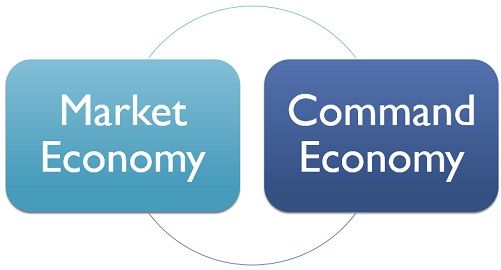
Understanding the Difference Between Market and Command Economies in the USA
Introduction to Market and Command Economies:
In the organization of economic activity, market economies and command economies represent two polar extremes. These systems differ primarily based on the control of factors of production and the mechanisms that determine prices. While market economies rely on the supply and demand of goods and services for organization, command economies are governed by centralized authorities. Examples of market economies include the USA, England, and Japan, while examples of command economies include East Germany, North Korea, and the former Soviet Union. However, most economies blend elements of both systems.
Market Economy: Key Features and Mechanisms:
Market economies are characterized by private ownership of the means of production and voluntary exchanges between economic actors. Capitalism is closely associated with market economies, where individuals and businesses freely own resources and engage in contracts without government interference. Adam Smith, in his concept of the “invisible hand,” described market activity as an uncoordinated distribution of resources. Prices, determined by supply and demand, act as signals for producers and consumers in a market economy. Government intervention in a market economy is minimal, limited to taxes and regulation. Consumers in a market economy are expected to protect their own interests, but inequality and injustice can be significant concerns.
Command Economy: Key Features and Mechanisms:
In a command economy, governments own the factors of production and regulate all aspects of production, including setting prices and production schedules. Decision-making is centralized, with macroeconomic and political considerations determining resource allocation. Ludwig von Mises argued that command economies are unsustainable as rational prices cannot emerge without private ownership. Milton Friedman, on the other hand, noted that command economies restrict individual freedom and often prioritize political self-interest over economic growth. Command economies aim to provide basic necessities and equal opportunities for all.
Blending Market and Command Principles in the USA:
While some countries lean more towards a market economy or a command economy, most nations, including the USA, incorporate aspects of both systems. The USA, known for its market economy, implemented planned economy measures during World War II. In recent years, market reforms have been introduced in previously command-oriented countries like Cuba. The relationship between economic systems and political systems is closely intertwined. Milton Friedman argued that command economies tend to become authoritarian regimes, but there are exceptions, such as democracies with a strong welfare state.
Advantages of a Market Economy in the USA:
Market economies in the USA offer several advantages. Prices are determined by consumer and producer decisions, leading to competition and efficient allocation of resources. The profit motive and competition also drive businesses to provide desirable products at competitive prices. However, market economies may struggle to address inequalities and may not prioritize access to essential goods and services for all members of society.
Advantages of a Command Economy in the USA:
Command economies allow governments to direct resources towards priorities that would not be adequately served by free-market forces. During times of crisis or war, countries often adopt central planning measures to prevent shortages. The COVID-19 emergency, for example, prompted the USA to invoke the Defense Production Act to ensure the production of vaccines and testing supplies. However, command economies can limit individual freedom and may not effectively promote long-term economic growth.
The Concept of a Mixed Economy:
A mixed economy combines elements of both socialism and capitalism, with government intervention to prevent shortages and address economic issues. Many countries, including China, Singapore, the United Kingdom, and several European nations, have mixed economies with a significant public sector and welfare programs. In reality, most countries exhibit elements of both market and command economies to varying degrees.
Conclusion:
Understanding the differences between market and command economies is essential for grasping the financial systems in the USA. While market economies emphasize private ownership and voluntary exchanges, command economies prioritize centralized government control over production and pricing. The USA, like many other countries, incorporates aspects of both systems, resulting in a mixed economy. The advantages and disadvantages of each system are essential considerations in shaping economic policies and promoting the well-being of the society within the USA’s geographic scope.
Other references:
- Investopedia – Difference Between Market Economy and Command Economy
- Brookings – The Russian Economy: What Is It and Where Is It Headed?
- Investopedia – Difference Between Command Economy and Mixed Economy
- Robinhood – What Is a Command Economy?
- White House – Fact Sheet: Executive Order on Promoting Competition in the American Economy
- Atlanta Fed – Economic Systems Infographic Activity Answer Key
- USINDOPACOM – USPACOM Area of Responsibility
- IMF – International Monetary Fund Issues and Challenges
- CDE – History-Social Science Content Standards
- StudySmarter – Command Economy Explanation
Leave a Reply